Monitoring Stream Health
Volunteers are invited to help collect macroinvertebrates, indicators of stream health.
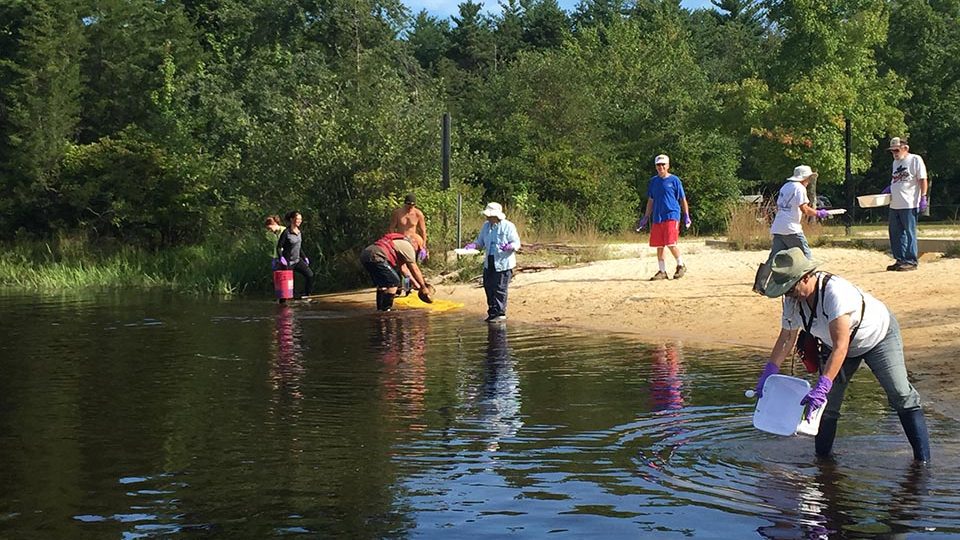
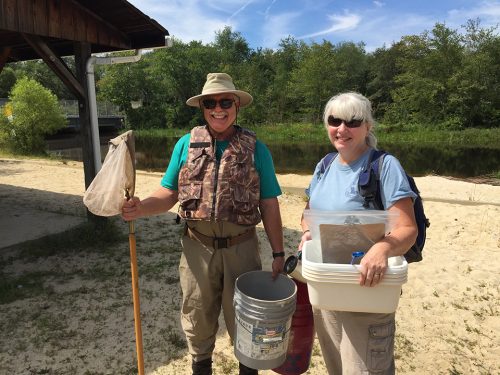
Decades ago Fred Akers, aka Watershed Fred, phoned me and asked if I wanted to check out a new program that the New Jersey Department of Environmental Protection had developed for citizen scientists. “It’s BATs,” Fred relayed, followed by his characteristic giggle.
“Bats?” I took the bait.
“Yes BATs, Biological Assessment Teams. You sample and identify cool critters in the stream called macroinvertebrates.”
“So, I have to get wet? I have to get muddy? Sounds good so far!”
Citizen science also has other labels, depending on what’s in vogue—participatory science, volunteer monitoring, public participation in scientific research…it basically boils down to getting the public involved in collecting data for analysis in order to answer questions about the health of our resources.
Fred and I arranged to meet at the West Side Park adjacent to Almond Road in Vineland, where the road crosses the Maurice River. Here Fred proceeded to get D nets out of his vehicle. These are essentially a wire hoop in the shape of a D, with a fabric mesh bag attached to a stick—picture a fabric crab dip net. He then laid a stash of ice trays on the table.
“We catch macroinvertebrates and place them in individual cells for identification. This will prove to be indicators of the stream’s health,” he told me, adding, “It’s really cool.”
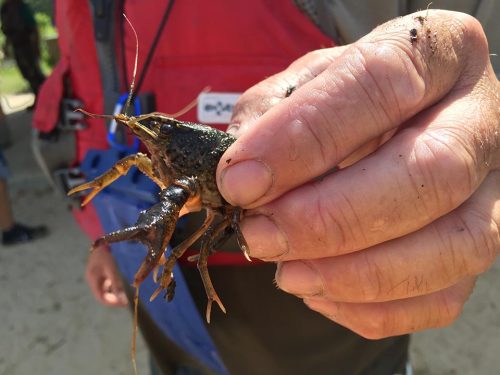
“Okay, then, let’s catch some neat critters. How do we know what we’ve caught?” I asked in a failed attempt to match his enthusiasm.
“Ah, we have these nifty cheat sheets, provided by the New Jersey Department of Environmental Protection.”
“Now you’re talking.” I think I liked the sound of that a bit too much; it seemed like we were up to something not only muddy, but slightly naughty too.
We proceeded to catch various organisms called benthic macroinvertebrates. Benthic refers to flora and fauna found at the bottom sediments of streams, lakes, rivers or other bodies of water, while macro means that we can see them with an unaided eye, although in my case a magnifying glass might have proved helpful. Invertebrates are animals lacking a backbone. Common macroinvertebrates typically include the larval stages of insects, like dragonflies, black flies, and mayflies. Then there are also permanent stream dwellers like mussels, snails, and crayfish.
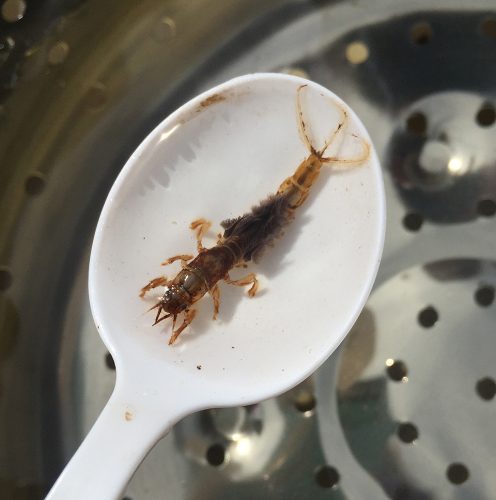
Why are macroinvertebrates important in determining water quality? The presence of macroinvertebrates gives us indicators about the health of a waterway. Each species has a different tolerance level to pollution. In New Jersey these critters are divided into a three-tier category. Pollution intolerant creatures are mayfly larva, stonefly larva, caddisfly larva (case-making), dobsonfly larva, water snipe fly larva, riffle beetle, water penny, and gilled snail. Pollution sensitive are caddisfly larva (net-spinning), alderfly larva, damselfly larva, dragon fly larva, crane fly larva, sowbug, crayfish, and clam/mussel. Pollution tolerant are black fly larva, midge fly larva, lunged snail, aquatic worm, and leech.
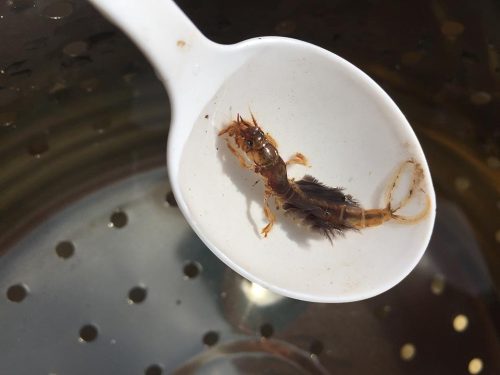 If pollution intolerant species are present, it is a strong indicator that the stream is healthier than it would be if they were absent. Pollution intolerant species can only survive in streams with little to no pollution. Some species like rat-tailed maggots tolerate high levels of pollution. Also know that diversity is important; ideally a healthy stream has benthic macroinvertebrates from all three categories. Finding only intolerant species would not be a complete-enough ecosystem. In general, while sampling streams it would be more likely to find pollution tolerant species present and intolerant ones absent. Fortunately in our limited sample, species from all levels were represented.
If pollution intolerant species are present, it is a strong indicator that the stream is healthier than it would be if they were absent. Pollution intolerant species can only survive in streams with little to no pollution. Some species like rat-tailed maggots tolerate high levels of pollution. Also know that diversity is important; ideally a healthy stream has benthic macroinvertebrates from all three categories. Finding only intolerant species would not be a complete-enough ecosystem. In general, while sampling streams it would be more likely to find pollution tolerant species present and intolerant ones absent. Fortunately in our limited sample, species from all levels were represented.
Other indicators of stream health: When looking at the health of a waterway many other components are studied by citizen groups and experts alike. The first aspect is a visual and habitat assessment that involves water temperature and general quality. For example, under optimal conditions a stream should have about a 70 percent mix of snags, submerged logs, and undercut banks allowing for shade. Leaf litter and other natural debris are also important for macroinvertebrates, fish, and other aquatic creatures.
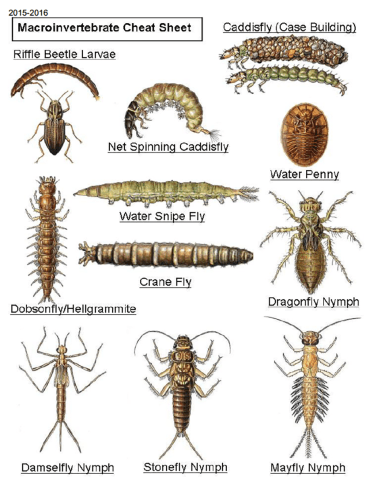
Varying water velocity across the stream is important as well. Riffles are shallower, faster-moving portions of waterways. In regions with rocks, as the water rushes over them it introduces oxygen. Put differently, turbulence increases oxygen in the water. In sandy streambeds, sticks and stumps can help to produce oxygen. Wind, submerged aquatic plant photosynthesis, and groundwater discharge—all of these also introduce oxygen into streams. Fish and aquatic organisms need that oxygen in water to survive.
Still water pools offer resting places for aquatic animals.
Colder water holds more oxygen. One reason we do not have trout streams in southern New Jersey is that our waters are warmer and lack a stony bottom for optimal oxygen levels in the summer. Therefore southern New Jersey streams will not support trout in the summer. This is why trout is stocked in the cooler months and encouraged to be kept.
Bacteria levels are another measure of stream health. Primary indicators of bacterial contamination are fecal pollution such as fecal coliform, Escherichia coli, and enterococci. These are potentially disease-causing organisms. Coliforms can’t be identified by look, taste, or smell, so detection generally involves a test for total coliforms. Fecal contamination can come from private septic systems, failing municipal systems, or animal waste.
Detection of chemical contamination is generally the job of government agencies and is controlled by discharge permits. Citizens can play a role in identifying problems by employing test strips or reagents to measure nitrate, phosphate, chloride, specific conductance, turbidity, pH, and dissolved oxygen, and by monitoring temperature.
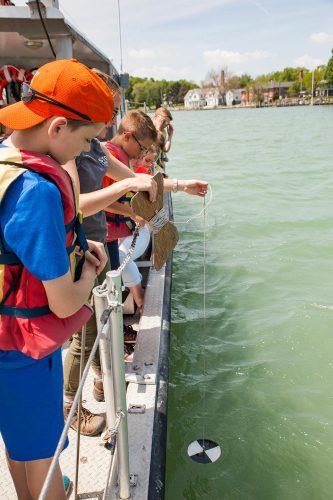
Nitrates and phosphates in excess amounts can produce accelerated eutrophication that often causes dramatic plant growth. This can manifest as algal blooms that rob sunlight and oxygen from the water. Plants do put oxygen into the water but dense growth can deplete oxygen levels, killing animals and desirable plants.
Volunteer water quality test kits often include a meter or probe for dissolved oxygen—a DO meter. DO levels are a primary indicator of aquatic environmental quality.
Too much turbidity and suspended solids also reduces oxygen. Storm events cause uncontained soils to enter roads, stormwater drains, and ultimately waterways. This causes reduced water clarity and in turn reduced DO. You can also think of suspended particulate/muck as fish smog.
To measure water clarity a simple and ingenious tool called a Secchi disk is utilized. Created in 1865, it is simply a disk divided into fourths with an alternating black and white surface pattern. It is lowered in the water and the user records the depth at which the disc is no longer visible to the eye.
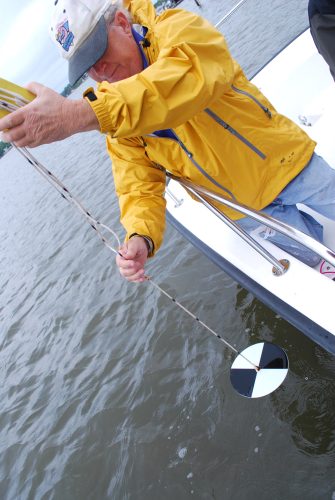
Since August 2015 CU Maurice River has coordinated dragonfly larvae collection for a National Park Service’s national mercury survey. Larvae accumulate mercury and ultimately give an indication of water and air quality. Collections are generally made over three days at three different sites, utilizing as many as 25 volunteers each day. These annual collections are ongoing. Sadly, they do show that there is mercury contamination in our local waterways.
Where does this mercury originate? The U.S. Geologic Survey identifies human-related sources primarily as “coal combustion, waste incineration, industrial uses, and mining. During the last 150 years, human activities have more than doubled natural amounts of mercury in the atmosphere.”
Watershed Fred and CU Maurice River have opened the eyes of many people to the world of volunteer monitoring and its benefits. Over time monitoring allows scientists and policymakers to detect changes in water quality. Monitoring our natural environment gives us an appreciation of the natural world and our role in it. It is by monitoring these trends that we can witness our failures and successes and gain a greater understanding of how it affects us and also how to help heal our ecosystems.
Source: NJ Dept. of Environmental Protection, Biological Assessment Manual, NJDEP Volunteer Monitoring Program.









